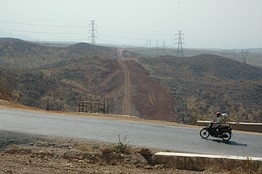
A new crude oil pipeline through Myanmar due to begin operations in September will put China in a favorable position compared to other Asian economic powerhouses challenged by energy security issues.
穿过缅甸的一条新原油管线定于9月开始运营,相比其他面临能源安全问题挑战的亚洲经济强国,这条管线将让中国处于有利地位。
At a capacity of 440,000 barrels a day, the pipeline--running from Myanmar's coast at the Bay of Bengal to China's southern Yunnan region--will allow China to send less crude through the Strait of Malacca. The narrow waterway by Singapore, where the U.S. Navy has a strong presence, is considered a major threat to secure energy supplies by major Asian economies dependent on crude shipments from the Middle East and Africa.
这条从缅甸位于孟加拉湾的海岸线到中国南方云南地区的管线每天可输送44万桶原油,让中国得以减少通过马六甲海峡运输的原油数量。对于依赖从中东和非洲运输原油的亚洲经济体来说,毗邻新加坡的狭窄航道马六甲海峡被认为是对安全能源供应的重大威胁。美国海军在新加坡驻有重兵。
China--helped by its own domestic oil production of just over 4 million barrels a day--last year relied on the narrow waters for around 37% of its total demand. That share will drop to about 30% once the Myanmar pipeline comes on stream.
在每天略高于400万桶的国内原油生产的帮助下,中国去年依赖马六甲海峡运输的原油占其总需求的37%左右。一旦缅甸的管线投入使用,这个比例将下降到30%左右。
In comparison, Japan, South Korea and Taiwan all rely on the Strait of Malacca for around 75% of their total oil consumption, in part due to their small domestic production.
相比之下,日本、韩国和台湾地区石油消耗总量的75%依靠马六甲海峡运输,部分原因是其国内原油产量很小。
The Myanmar pipeline, which will run parallel to a major natural gas pipeline, comes on top of a string of oil and gas import pipelines already completed or planned to supply China's less-developed inland regions.
缅甸原油管线与一条重要天然气管线平行,在此之前已经有一系列向中国欠发达内陆地区输送油气的已完工或规划中的油气进口管线。
In 2009, a new pipeline from Russia began pumping Siberian crude into northern China, and in March this year, the two countries agreed to double shipments to 620,000 barrels a day. They also agreed in principle on a new pipeline that will feed northeastern China with 38 billion cubic meters of Russian natural gas a year starting in 2018.
2009年,一条从俄罗斯起始的新管线开始将西伯利亚原油输送到中国北部,今年3月,中俄两国达成协议,将输送的原油数量增加一倍,至每天62万桶。两国还大体上就新建一条天然气管线达成协议,该管线将从2018年起每年向中国东北输送380亿立方米俄罗斯天然气。
Also in 2009, a pipeline began operations that stretches 4,000 kilometers across Central Asia and is capable of shipping 30 billion cubic meters of gas a year from Turkmenistan to western China. Oil imports from neighboring Kazakhstan began in 2005, and are set to double to 400,000 barrels a day when expansion at an existing pipeline is completed next year.
同样在2009年,一条绵延4,000公里、横贯中亚的管线开始运行,这条管线每年能够从土库曼斯坦向中国西部输送300亿立方米天然气。从哈萨克斯坦进口石油从2005年开始,而且进口量将在明年一条现有管线完成扩容后增加一倍,达到每天40万桶。
While the oil pipeline could reach full capacity soon after launch, the gas pipeline is not expected to be filled until Myanmar ramps up production from its offshore fields. Furthermore, the Wood Mackenzie energy consultancy estimates that CNPC is building the pipelines through Myanmar at a short-term loss, as it will buy gas at market price and sell it at subsidized prices at home.
虽然缅甸的石油管线可能在投入使用后不久达到满负荷运行,但天然气管线预计在缅甸加强其海上气田生产之前将无法发挥全部产能。此外,能源咨询机构Wood Mackenzie估计,中国石油天然气集团公司(CNPC)是以短期亏损为代价修建通过缅甸的管线,因该公司将以市场价购买天然气,然后在国内以补贴价出售。
'The Chinese are willing and capable of taking a long-term view,' said Wood Mackenzie analyst Craig McMahon.
Wood Mackenzie分析师麦克马洪(Craig McMahon)说,中国人愿意从长远角度看问题,也有能力这样做。


